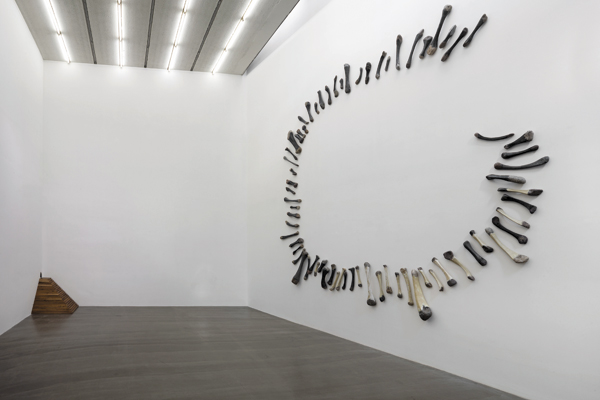 |
|
"Lateral Edge", the latest solo exhibition by artist Li Gang at Galerie Urs Meile. Sun Yuanqing / China Daily |
Operating costs in the major art districts in Beijing have also been rising rapidly. Red Gate Gallery, the oldest private contemporary art gallery in China, shut down its branch in the 798 Art Zone in 2008 due to increasing rent. Even in Caochangdi, a newer and smaller art district, Pekin Fine Arts has seen its cost double since it opened in 2005.
However, Guan Yu, director and general manager of Art Market Monitor of Artron in Beijing, believes the core problem facing the city's galleries lies in the absence of criteria in the evaluation of Chinese contemporary art, which can make it risky for collectors in terms of investment. And investment, rather than art itself, is what has been driving the Chinese art market.
"The market is very vulnerable to the changes of the macro economy. People still have money, but because of the slow economy they don't have confidence," said Cheng from AGA.
Last year, the Chinese art market, usually evaluated by auction results, fell 40 percent in annual sales, and was surpassed by the US again. In Sotheby Hong Kong's contemporary Asian art sales last autumn, a benchmark for Asian and Chinese art market, nearly 30 percent of the lots went unsold.
Cheng estimates that average sales for galleries in Beijing in 2012 declined 20 percent from 2011.
Without any substantial support from the government, for instance in the form of subsidies, the prospects for galleries in Beijing look far from promising, Cheng said.
"If the economy doesn't pick up and the business environment in Beijing doesn't improve, we will see more galleries, both local and foreign ones, pulling out over the next three years," Cheng said.
To survive a time like this, Ma from AMRC believes a gallery has to have either an extensive and established clientele, or strong financial support coupled with grit and determination.
"It is the galleries without long-term plans that are in danger of pulling out," Ma said.
Slashing costs is the obvious response by galleries at present.
The Xin Dong Cheng Gallery plans four exhibitions this year, compared with six last year, and will attend three international art fairs, down from seven or eight in the past.
The gallery also plans to work with collectors, corporations and universities to provide professional services in education and consulting to explore new ways of income.
"Galleries need to be more than a trading platform," Cheng said. Developing art-related products is another option.
The Ullens Center of Contemporary Art makes a reported 10 million yuan ($1.61 million) a year from its store sales, which covers about half of its operating costs.
"These products might not be expensive, but they have an extensive base of consumers. And this could be a trend for art galleries in the future," Cheng said.
At the same time, social media-savvy galleries are reaching out to new potential clients via weibo, China's micro-blogging sites.
"Our big strategy since last year is to really develop our social media presence," said Brian Wallace, founder and director of Red Gate Gallery.
While many Chinese galleries don't use social media, those who do usually don't update it for weeks. Red Gate's weibo account had about 54,000 followers as of early April, the most among the galleries in China. It is bringing a new group of clients to the gallery.
|
|
|
|
|
|
|
|
|
|
|